At this point, most people have at least heard of blockchain, but it’s become something of a running joke how complex the technology can be to understand. Chances are you associate the technology with Bitcoin, but while that was the first real-world application of blockchain technology, it’s far from the only use case.
What Is Blockchain?
While some people equate the invention of blockchain with Bitcoin’s pseudonymous founder Satoshi Nakomota, the concept has been around since 1991, first coined in a paper by researchers Stuart Haber and W. Scott Stornetta called "How to Timestamp a Digital Document."
Also known as distributed ledger technology (DLT), the blockchain is a record that anyone can add to, that nobody can change, and that isn't controlled by any one person or entity. The core concept is a public ledger with copies spread out among multiple locations called nodes, which usually refer to individual computers with copies of the ledger.
This is what people mean when they refer to the blockchain as decentralized. No one person or entity has control of the information kept in the record. Instead, it’s distributed among the many nodes that make up the network.
In order to change the ledger, those changes must first be verified by everyone on the network. As long as all copies of the record match, the system knows it can update the information. This increases the difficulty of changing anything stored within the blockchain while building trust in the information that’s recorded.
As journalist Mike Orcutt put it in the MIT Technology Review, "The whole point of using a blockchain is to let people—in particular, people who don’t trust one another—share valuable data in a secure, tamperproof way.”
Continue reading: https://www.pcmag.com/how-to/what-is-the-blockchain-and-whats-it-used-for
What Is Blockchain?
While some people equate the invention of blockchain with Bitcoin’s pseudonymous founder Satoshi Nakomota, the concept has been around since 1991, first coined in a paper by researchers Stuart Haber and W. Scott Stornetta called "How to Timestamp a Digital Document."
Also known as distributed ledger technology (DLT), the blockchain is a record that anyone can add to, that nobody can change, and that isn't controlled by any one person or entity. The core concept is a public ledger with copies spread out among multiple locations called nodes, which usually refer to individual computers with copies of the ledger.
This is what people mean when they refer to the blockchain as decentralized. No one person or entity has control of the information kept in the record. Instead, it’s distributed among the many nodes that make up the network.
In order to change the ledger, those changes must first be verified by everyone on the network. As long as all copies of the record match, the system knows it can update the information. This increases the difficulty of changing anything stored within the blockchain while building trust in the information that’s recorded.
As journalist Mike Orcutt put it in the MIT Technology Review, "The whole point of using a blockchain is to let people—in particular, people who don’t trust one another—share valuable data in a secure, tamperproof way.”
Continue reading: https://www.pcmag.com/how-to/what-is-the-blockchain-and-whats-it-used-for

